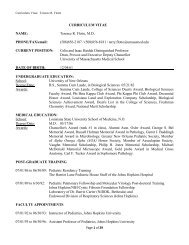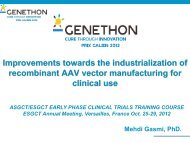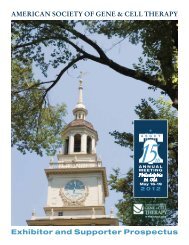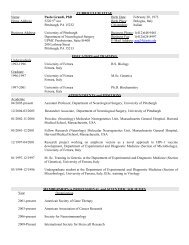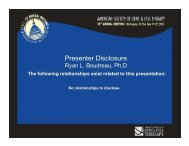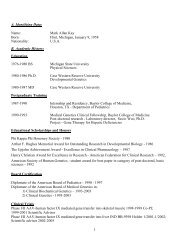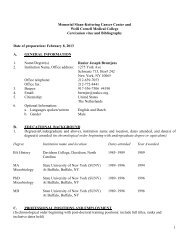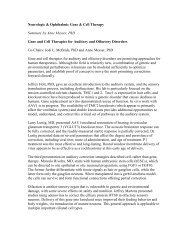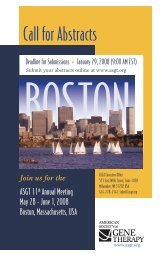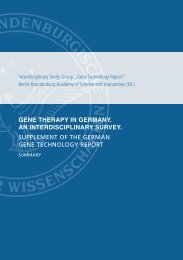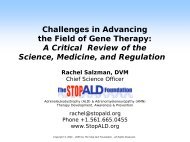FINAL PROGRAM - American Society of Gene & Cell Therapy
FINAL PROGRAM - American Society of Gene & Cell Therapy
FINAL PROGRAM - American Society of Gene & Cell Therapy
- No tags were found...
You also want an ePaper? Increase the reach of your titles
YUMPU automatically turns print PDFs into web optimized ePapers that Google loves.
13 th AnnUAL MEETing | Washington, DC USA May 19-22, 2010 39Program ScheduleEducation Session 1335:30 pm - 7:00 pmRoom: Virginia SuiteTopical Review: Immunotherapy <strong>of</strong> CancerThe immune system can be properly modified to eradicate cancer. Currently, effector molecules, such as monoclonal antibodies and cells such as tumor-reactive lymphocytes,are able to selectively target and eliminate tumors, may be isolated and/or engineered. The potency <strong>of</strong> cellular adoptive immunotherapy has been revealed bypersistent and complete clinical responses obtained with by the transfer <strong>of</strong> allogeneic T lymphocytes in the context <strong>of</strong> allogeneic hemopoietic cell transplantation (allo-HSCT) and by the transfer <strong>of</strong> autologous tumor specific cytotoxic T lymphocytes (CTLs) in cancer patients. Major hurdles limiting adoptive T cell therapy relate to toxicity(ie: graft-versus-host disease-GvHD in allo-HSCT), feasibility and efficacy (ie: difficulty in expanding rare, high-avidity tumor-specific CTLs). <strong>Gene</strong> transfer technologies mayallow to overcome all these hurdles. The transfer <strong>of</strong> tumor-specific TCR or chimeric antigen receptors (CARs), confers tumor-specificity and activity to autologous T cells.The transfer <strong>of</strong> a suicide gene into allogeneic lymphocytes allows to tame toxicity <strong>of</strong> allogeneic lymphocytes. In this session, we will discuss clinical results, challenges andadvances recently made to improve the potency and specificity <strong>of</strong> adoptive immunotherapy with genetically modified lymphocytes to treat cancer.ChairChiara Bonini, MDSpeakersRichard A. Morgan, PhDUsing Engineered T <strong>Cell</strong>s for the Treatment <strong>of</strong> CancerAdoptive cell transfer (ACT) using anti-tumor antigen reactive T cells has proven to be a useful strategy for the treatment <strong>of</strong> metastatic melanoma, with objective responserates <strong>of</strong> up to 72%, with 16% <strong>of</strong> patients rendered disease free. These studies involved the extraction and ex-vivo expansion <strong>of</strong> naturally occurring tumor infiltratinglymphocytes (TIL). Only one-half <strong>of</strong> patients are able to receive this therapy due to lack <strong>of</strong> harvestable tumors, inability to grow TIL, or a lack <strong>of</strong> cellular reactivity. Recentstrategies aimed at broadening ACT involve the use <strong>of</strong> chimeric antigen receptors (CAR) or T-cell receptor (TCR) genes specific for tumor associated antigens and the use <strong>of</strong>viral vectors to transduce these genes into peripheral blood lymphocytes. TCR gene therapy has been applied with some success in recent trials targeting MART-1, gp100and NY-ESO-1. CAR gene therapy trials are also showing promising results in protocols targeting CD19+ lymphomas. Efforts aimed at improving the response rate andminimizing on-target toxicity are in progress.Gianpietro Dotti, MDCar-Based <strong>Gene</strong> Transfer in T LymphocytesExpression <strong>of</strong> a transgenic “T-body” or “chimeric antigen receptor” (CAR) in human T lymphocytes combines the specificity <strong>of</strong> an antibody with the homing and target-celldestruction capabilities <strong>of</strong> T cells. This technology was first described 15 years ago, and after significant improvements in gene transfer technologies and better understanding<strong>of</strong> immunological pathways is now reaching a critical phase <strong>of</strong> clinical evaluation. In this presentation we will summarize the concept <strong>of</strong> CAR-based immunotherapy,describe the steps accomplished, and outline the future progress we need to make if this approach is truly to improve cancer immunotherapy.Chiara Bonini, MDT-<strong>Cell</strong> Based <strong>Gene</strong> <strong>Therapy</strong> in Hematopoietic Stem <strong>Cell</strong> TransplantationThe potency <strong>of</strong> cellular adoptive immunotherapy for the treatment <strong>of</strong> cancer has been clearly revealed by the persistent and complete clinical responses observedin patients undergoing allogeneic hematopoietic stem cell transplantation (allo-HSCT) followed by the adoptive transfer <strong>of</strong> donor T lymphocytes. However, severalhurdles remain to be overcome before adoptive immunotherapy can become a broadly applicable therapeutic approach to treat cancer, and gene transfer approachesrepresent ideal solutions to overcome these hurdles. In allo-HSCT, most <strong>of</strong> the antileukemic potential resides in alloreactivity towards patient-specific antigens, such asminor and major histocompatibility antigens, by donor lymphocytes. Unfortunately, alloreactivity is also responsible for the most serious and frequent complication <strong>of</strong>allo-HSCT: the Graft-versus-Host-Disease (GvHD). The risk <strong>of</strong> GvHD increases with the level <strong>of</strong> HLA disparity between host and donor, and leads to impaired quality <strong>of</strong>life and reduced survival expectancy, particularly in patients transplanted from HLA-mismatched donors. <strong>Gene</strong> transfer technologies are promising tools to manipulatedonor T cell immunity to enforce the graft-versus-tumor (GvT) effect, to promote a functional post-transplant immune reconstitution (graft-versus-infection-GvI) and toprevent or control GvHD. To this purpose, several cell and gene transfer approaches, have been investigated at pre-clinical level, and are being implemented in clinicaltrials. The majority <strong>of</strong> these approaches, based on negative or positive selection <strong>of</strong> specific T cell subpopulations, aim at reducing the repertoire <strong>of</strong> donor lymphocytesinfused with or after the graft, so to prevent alloreactivity. In contrast, suicide gene therapy aims at a selective control <strong>of</strong> GvHD in treated patients, thus permittingthe full exploitation <strong>of</strong> alloreactivity against cancer cells. In a phase I-II clinical trial enrolling 54 pts undergoing haploidentical HSCT, we showed that the transfer <strong>of</strong> asuicide gene into donor lymphocytes, allows to provide rapid and effective immune reconstitution, and control <strong>of</strong> GvHD. By taming the toxicity <strong>of</strong> allo-HSCT the suicidegene approach renders haploidentical HSCT a feasible, safe and more effective option for cancer patients <strong>of</strong> all ages. <strong>Cell</strong> and gene therapy approaches currentlyimplemented for a safe exploitation <strong>of</strong> donor immunity against cancer, in the context <strong>of</strong> allo-HSCT will be discussed.Wednesday, May 19 th



